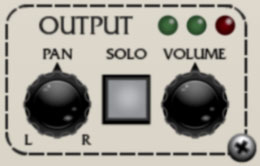
Pan- Moves the sound of each voice between the left and right channels. We don't need to tell you what to do with a pan knob, but one super great Eight Voice trick is to create a homogenous eight-voice poly patch, then set the pans randomly for each voice. This is even neater if the tuning controls are minutely varied for each voice - beautiful stereo pads can be created this way.
Solo- The Solo button glows, and audio is disabled for all other modules. Other modules are also visibly dimmed.
If the voice is currently set to Poly A or Poly B, the number of voices of polyphony is temporarily reduced to only the soloed module. This is similar to the "hold" function of the original Oberheim Two/Four/Eight Voice instruments, and it makes sound editing much easier. If it didn't work this way, if you had four voices set to Poly A, for example, only every fourth note would sound the soloed module, which would make sound editing a drag (or you'd need to switch the voice assign switch to one of the mono modes).
Multiple voices can be soloed, and if they're set to Poly A or Poly B, their triggering will depend on the setting of the Poly Assign Mode switch. Generally speaking, it makes the most sense to solo one voice at a time when in one of the poly modes.
Volume and output meter LEDs- Obviously this affects the loudness of the voice, but do pay attention to overall master volume, as the cumulative volume of multiple voices can really stack up. The red meter LED will glow when things are getting too hot. You'll also notice that, in addition to the main Voice activity LED, the meters are useful for a quick visual reference of which voices are currently playing.